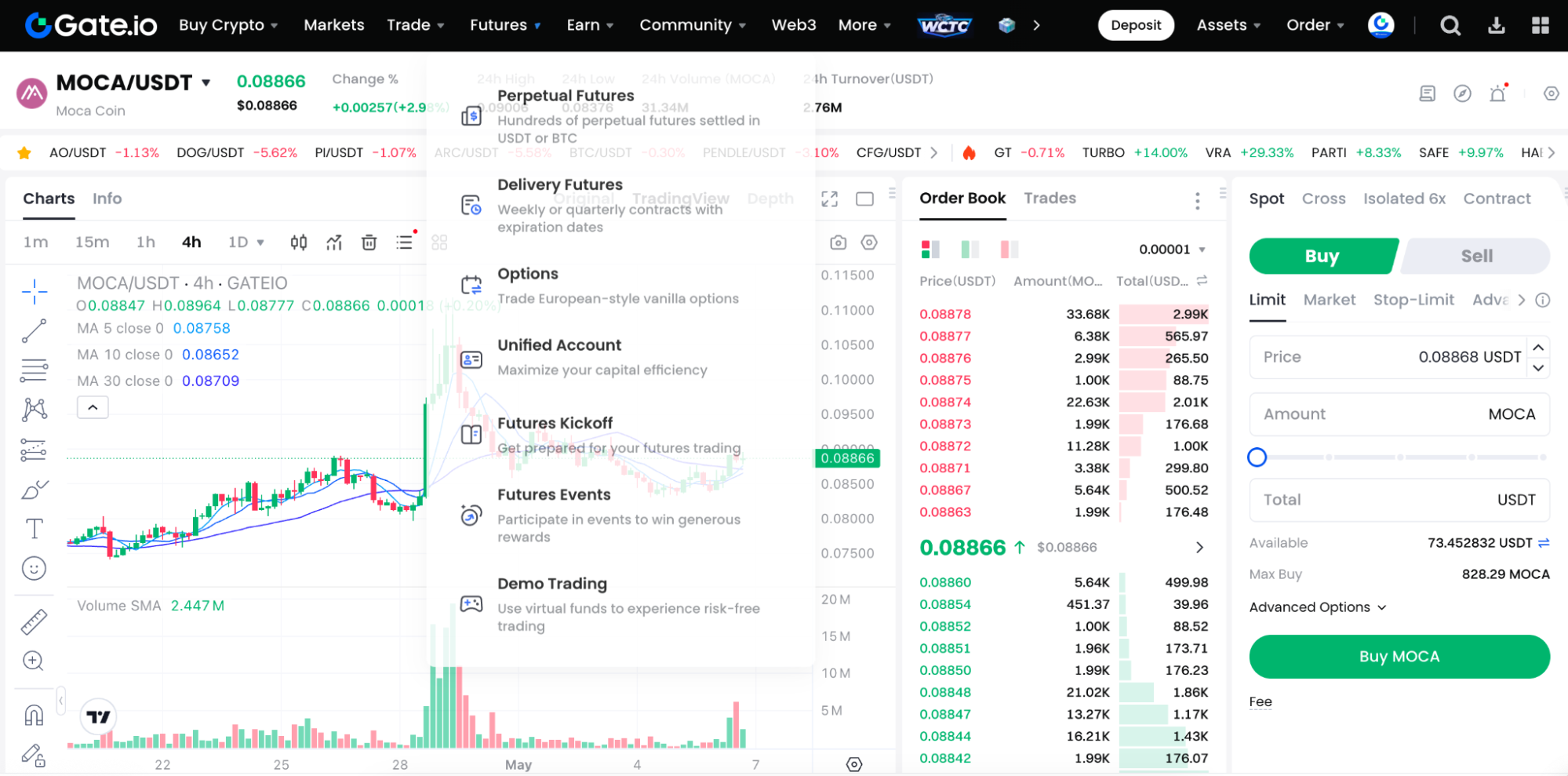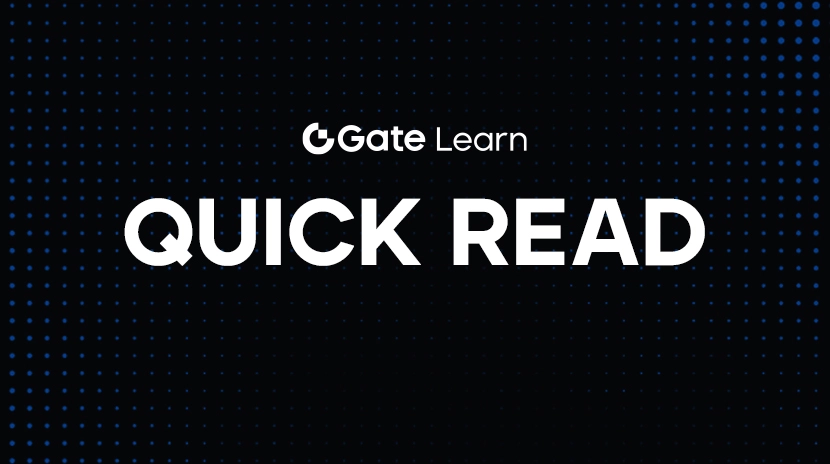什么是 Moca Network:数字身份基础设施的创新与展望
一、引言
在数字化时代,数字身份是个人或组织在网络空间中的标识,承载着丰富的信息,是参与各类线上活动的基础。然而,当前数字身份体系存在严重的碎片化问题。用户在不同的 Web2 平台,如社交网络、电商平台、在线游戏等,以及 Web3 应用,如去中心化金融(DeFi)、非同质化代币(NFT)市场等,都需要创建和管理多个独立的身份。这种碎片化导致用户难以统一管理自身数字身份,在不同平台间切换时体验不佳;企业也难以全面了解用户,精准营销和服务受到阻碍,造成效率低下和资源浪费。
Moca Network 作为致力于解决数字身份碎片化问题的创新项目,提出了全新的思路和方案。

登录 Gate.io 交易平台,即可进行 MOCA 交易:https://www.gate.io/trade/MOCA_USDT
二、Moca Network 基础认知
2.1 定义与所属项目背景
Moca Network 是 Animoca Brands 集团旗下的重要项目,其核心目标是建立全球最大的元宇宙消费者网络。Animoca Brands 在区块链和数字娱乐领域具有广泛的影响力和丰富的资源,旗下拥有众多知名的区块链游戏和数字资产项目,为 Moca Network 的发展提供了坚实的后盾和广阔的生态基础。
Moca Network 致力于构建一个开放、包容的元宇宙生态系统,让用户能够在其中创建独一无二的数字身份。这种数字身份不仅仅是一个简单的账号标识,更是用户在元宇宙世界中的数字代表,承载着用户的个人信息、偏好设置、社交关系等多维度数据。通过这个数字身份,用户可以自由地穿梭于不同的元宇宙应用场景,实现数据的无缝衔接和交互。
在 Moca Network 的生态中,用户还能够积累声誉。声誉系统基于用户在元宇宙中的各种行为和贡献进行评估,例如积极参与社区活动、对优质内容的创作和分享、对其他用户的帮助等,都会提升用户的声誉值。高声誉的用户将在生态中获得更多的认可和特权,如优先参与某些限量活动、获得专属的奖励和福利等。同时,用户还能够在这个网络中赚取和消费积分。积分可以通过完成任务、参与游戏、交易等多种方式获得,并且可以用于在元宇宙中购买虚拟商品、服务,或者参与特定的活动,为用户提供了更加丰富和多元化的体验。
2.2 发展历程回顾
Moca Network 自创立以来,经历了多个重要的发展阶段,逐步在元宇宙和数字身份领域崭露头角:
- 项目启动与初步探索:在成立初期,Moca Network 专注于概念的验证和技术架构的搭建。团队深入研究元宇宙和数字身份领域的技术趋势和用户需求,确定了以构建开放互联网数字身份基础设施为核心目标。通过对区块链、加密技术等底层技术的研究和应用,初步建立了 Moca Network 的技术框架,为后续的发展奠定了基础。
- 核心产品开发与市场推广:这一阶段,Moca Network 集中精力开发核心产品,推出了 Mocaverse 等具有代表性的元宇宙应用。Mocaverse 为用户提供了一个充满想象力的虚拟世界,用户可以在其中创建自己的数字身份,与其他用户互动交流,参与各种有趣的活动。同时,Moca Network 积极开展市场推广活动,与多家知名企业和机构建立合作关系,扩大项目的知名度和影响力,吸引了第一批用户和合作伙伴的加入。
- 融资与生态拓展:随着项目的发展,Moca Network 获得了资本市场的关注和支持。Animoca Brands 旗下的 Mocaverse 完成了 1000 万美元融资,OKX Ventures、CMCC Global 和 HongShan 等知名投资机构参投。这笔资金主要用于开发消费者加密基础设施,加速了 Moca Network 的生态拓展。在此期间,Moca Network 与 Magic Eden 联合推出 MagicMoca NFT Launchpad,这是一个专为 Mocaverse 社区设计的 NFT Launchpad 平台,旨在促进游戏和 IP NFT 项目的发布,进一步丰富了生态系统的内容和应用场景。
- 技术升级与战略转型:近期,Moca Network 发布了 MOCA 3.0 愿景,标志着项目进入了一个新的发展阶段。MOCA 3.0 致力于为开放互联网构建数字身份基础设施,将重点放在解决数字身份碎片化问题上,从以项目为中心转变为以用户为中心,构建开放网络。通过引入 AIR Kit、凭证体系等创新技术和机制,Moca Network 旨在为用户提供更加便捷、安全、高效的数字身份管理和应用体验,同时也为企业和开发者提供了更强大的工具和平台,推动整个元宇宙生态系统的发展。
三、核心技术与特性
3.1 AIR Kit 详解
AIR Kit 作为 Moca Network 的核心组件之一,是一个通用账户系统,在数字身份管理和用户交互方面发挥着关键作用,它为用户提供了统一账户、身份和声誉管理的基础功能,是实现 Moca Network 愿景的重要技术支撑。
3.1.1 通用账户系统特性
AIR Kit 的首要特性是与区块链无关,这使其具备了在各种环境中运行的能力。无论是基于以太坊、比特币等主流区块链,还是新兴的区块链项目,AIR Kit 都能够无缝适配 。这种独立性打破了区块链之间的技术壁垒,使得用户无需担心不同区块链系统的差异,能够在多链环境中自由切换和使用。例如,在以太坊生态中进行去中心化金融(DeFi)操作的用户,同时也能利用 AIR Kit 在波卡生态的应用中进行交互,实现资产和身份的统一管理。
高度互操作性是 AIR Kit 的另一大特性。它允许用户轻松地统一和管理自己在不同平台和应用中的数字身份。在传统的数字身份管理模式下,用户在不同平台注册的身份相互独立,难以进行整合和统一管理。而 AIR Kit 通过建立通用账户系统,使用户能够将分散在各个平台的数字身份集中管理,实现数据的互联互通。用户在社交媒体平台、电商平台以及游戏平台等不同场景下的身份信息,都可以通过 AIR Kit 进行整合,方便用户进行统一的操作和管理。
3.1.2 账户与身份连接机制
在 AIR Kit 中,身份 ID 是用户与服务之间的重要接口,它就像是一把钥匙,能够开启用户在不同服务平台的数字身份之门。而账户则充当了连接用户各种身份和活动的中枢,如同一个信息汇聚的中心。以 Mocaverse 上的 MOCA ID 和 OneFootball 上的 FOOTBALL ID 为例,这两个不同平台的身份 ID 都可以链接到同一个 AIR 账户 。当用户在 Mocaverse 中创建了 MOCA ID,并参与了一系列活动,如购买虚拟土地、参与社交互动等,这些活动记录都会被关联到对应的 AIR 账户。同时,用户在 OneFootball 上使用 FOOTBALL ID 进行赛事预测、球迷社区交流等活动时,相关数据也会被整合到同一个 AIR 账户中。尽管 MOCA ID 和 FOOTBALL ID 在各自的平台上保持独立,拥有不同的属性和功能,但通过 AIR 账户的连接,用户可以在一个统一的界面下查看和管理自己在不同平台的身份和活动信息,极大地提高了数字身份管理的效率和便捷性。
3.1.3 对用户体验的优化
AIR Kit 在优化用户体验方面做出了诸多努力。在 Web3 领域,传统的钱包创建过程往往较为复杂,需要用户掌握一定的技术知识,如理解私钥、助记词等概念,并且操作步骤繁琐。而 AIR Kit 的出现改变了这一现状,它使得用户创建 Web3 钱包就像使用社交登录一样简单。用户只需通过简单的几步操作,如输入常用的社交账号信息或手机号码,即可快速创建 Web3 钱包,无需深入了解复杂的区块链地址和私钥管理机制,降低了用户进入 Web3 世界的门槛。
在 gas 费用支付方面,AIR Kit 也进行了优化。在以太坊等区块链网络中,gas 费用的波动和支付方式的复杂性常常给用户带来困扰。AIR Kit 通过整合多种支付方式和智能算法,帮助用户更合理地支付 gas 费用。它可以根据市场情况和用户需求,自动选择最优的 gas 价格,避免用户支付过高的费用。同时,AIR Kit 还支持多种支付货币,用户可以使用稳定币或其他主流加密货币支付 gas 费用,提高了支付的灵活性和便捷性。在跨链交易方面,AIR Kit 简化了交易流程,减少了用户在跨链操作中的等待时间和操作步骤,提升了用户在不同区块链之间转移资产和交互的体验。
3.2 凭证体系解析
Moca Network 的凭证体系是其实现用户数据主权和构建可信数字身份生态的重要基础设施,它为用户提供了对自身数据的有效管理和控制能力,同时保障了数据的安全和隐私。
3.2.1 凭证系统功能概述
Moca Network 的凭证系统具备颁发、存储和验证凭证的全面功能。在颁发环节,它可以与各种可信的机构或平台合作,为用户生成具有权威性的数字凭证。这些凭证可以涵盖用户的身份信息、学历证明、职业资格证书、信用记录等多个方面。例如,教育机构可以通过 Moca Network 的凭证系统为学生颁发学历证书凭证,企业可以为员工颁发职业技能证书凭证等。
在存储方面,Moca Network 将凭证数据安全地保存在去中心化数据存储中,这种存储方式避免了中心化存储的单点故障和数据被篡改的风险。用户的数据被加密存储在分布式节点上,只有用户本人拥有解密和访问的权限,确保了数据的安全性。用户可以直接设置和管理其凭证的访问权限,决定哪些人或应用可以查看自己的凭证信息,以及在何种条件下可以访问。用户可以选择将自己的学历凭证仅向招聘企业开放,或者将信用记录凭证向金融机构共享,实现了对个人数据的精准控制。
在验证环节,Moca Network 提供了高效、可靠的验证机制。当第三方需要验证用户的凭证真实性时,可以通过 Moca Network 的验证接口进行查询和验证。验证过程基于区块链的不可篡改特性和加密算法,确保了凭证的真实性和有效性,为用户在各种场景下的身份验证和数据使用提供了有力保障。
3.2.2 数据安全与隐私保护
为了保护数据安全,Moca Network 采用了先进的防篡改技术。在区块链环境中,每一笔数据的更新和存储都需要经过多个节点的验证和共识,一旦数据被记录在区块链上,就很难被篡改。如果有人试图篡改用户的凭证数据,这种篡改行为需要同时修改多个节点的数据,而这在分布式的区块链网络中几乎是不可能实现的,从而保证了凭证数据的完整性和可靠性。
零知识证明(ZKP)技术也是 Moca Network 保障数据安全和隐私的重要手段。零知识证明允许一方(证明者)向另一方(验证者)证明某个陈述是真实的,而无需透露除了该陈述为真之外的任何其他信息。在 Moca Network 的凭证体系中,当用户需要向第三方证明自己拥有某种凭证或具备某种属性时,可以使用零知识证明技术。用户在不透露自己具体学历信息的情况下,向招聘企业证明自己拥有本科及以上学历,既满足了验证需求,又保护了个人隐私。
Moca Network 还计划采用 zkTLS 技术,实现 Web2 数据在链上的安全验证和使用。zkTLS 技术结合了零知识证明和传输层安全协议(TLS),能够在保证数据传输安全的同时,实现对 Web2 数据的隐私保护。通过这种技术,用户可以将 Web2 平台上的数据安全地整合到 Web3 的凭证体系中,进一步丰富了数字身份的内涵和应用场景,同时确保了数据在不同环境下的安全性和隐私性。
3.2.3 跨链与智能合约交互
在跨链方面,Moca Network 允许用户通过 LayerZero 或 Wormhole 等跨链消息传递协议在不同系统间传输凭证。这些跨链协议就像桥梁一样,连接了不同的区块链网络,使得用户的凭证能够在不同链之间自由流动。用户在以太坊链上拥有的数字身份凭证,可以通过跨链消息传递协议,安全地传输到币安智能链或其他区块链上,实现了凭证的跨链互认和使用。这为用户在多链环境下的活动提供了便利,打破了区块链之间的壁垒,促进了数字身份生态的融合和发展。
在与智能合约交互方面,Moca Network 的凭证体系使用户能够安全地直接与任何链上的智能合约互动。智能合约是区块链应用的核心,它能够自动执行预设的规则和条件。Moca Network 的用户可以利用自己的凭证数据作为智能合约的输入参数,触发智能合约的执行。在去中心化金融(DeFi)应用中,用户可以使用自己的信用凭证作为抵押,申请贷款或参与其他金融活动。智能合约会根据用户的凭证信息,自动判断用户的信用等级和可贷款额度,实现快速、安全的金融交易。这种与智能合约的交互方式,不仅提升了用户从其凭证中获取价值的能力,也为区块链应用的创新和发展提供了更多的可能性。

四、应用场景探索
4.1 游戏领域应用
在游戏领域,Moca Network 展现出了强大的赋能能力,为游戏玩家带来了全新的体验,也为游戏开发者和运营商提供了更高效的运营模式。
Moca Network 允许用户在游戏中赚取积分,这些积分具有多种用途,极大地丰富了游戏的经济体系和用户激励机制。以 Mocaverse 为例,用户可以通过完成游戏中的各种任务,如探索虚拟世界、完成主线剧情、参与竞技比赛等,获得积分奖励。这些积分可以在游戏内的商店中兑换珍稀的虚拟道具,如独特的武器装备、华丽的角色皮肤等,提升玩家在游戏中的竞争力和个性化体验。同时,积分还可以用于参与游戏内的特殊活动,如限时抽奖、拍卖等,增加游戏的趣味性和互动性。用户还可以将积分积累起来,用于解锁更高级的游戏内容和特权,激励玩家持续投入时间和精力在游戏中。
通过 Moca Network,不同游戏之间可以实现身份的统一和数据的共享。玩家无需在每个新游戏中重新注册和创建角色,只需使用 Moca Network 的统一身份,就可以畅玩多个游戏。这不仅节省了玩家的时间和精力,还实现了游戏资产和成就的跨游戏继承。玩家在一款角色扮演游戏中积累的等级、装备和技能等数据,可以通过 Moca Network 同步到其他相关游戏中,使玩家在不同游戏中的体验更加连贯和丰富。这种身份统一和数据共享的模式,促进了游戏生态的融合和发展,为玩家提供了更加开放和多元化的游戏体验。
Moca Network 的引入,使得游戏内的社交互动更加便捷和高效。玩家可以通过 Moca Network 的社交功能,与其他玩家建立联系,组建团队,共同参与游戏活动。在多人在线游戏中,玩家可以轻松地查找和邀请好友加入自己的队伍,共同挑战强大的 BOSS 或者参与激烈的 PVP 对战。同时,Moca Network 还支持玩家之间的实时通讯和信息共享,方便玩家在游戏中交流战术、分享游戏心得和经验。这种便捷的社交互动,增强了玩家之间的粘性和互动性,提升了游戏的社交氛围和玩家的归属感。
4.2 体育产业融合
Moca Network 与体育产业的融合,为体育领域带来了数字化变革,提升了体育赛事的观赏体验,促进了体育产业的创新发展。
以 OneFootball 与 Moca Network 的合作为例,双方推出了 Football ID,为足球迷提供了全新的参与体验。球迷可以通过 OneFootball 应用程序申请个性化 DID,如 name.football。拥有 Football ID 的球迷可以访问 Moca 网络中的各种体验,包括 GameFi、知识产权和音乐等 。在 GameFi 方面,球迷可以参与基于足球主题的游戏化金融应用,通过预测比赛结果、参与虚拟球员交易等方式,获得相应的奖励和收益,增加了对足球赛事的参与感和互动性。在知识产权方面,球迷可以获取与足球相关的独家数字内容,如球员的签名 NFT、经典比赛的精彩瞬间回放等,丰富了足球文化的消费形式。在音乐方面,球迷可以欣赏到专门为足球赛事创作的音乐作品,或者参与音乐相关的互动活动,进一步增强了对足球文化的认同感和归属感。
通过 Moca Network,体育赛事的组织者和运营者可以更好地了解球迷的需求和行为,实现精准营销和个性化服务。Moca Network 的数据分析功能可以收集球迷在平台上的各种行为数据,如观看比赛的频率、关注的球队和球员、参与互动活动的类型等。基于这些数据,赛事组织者可以为球迷推送个性化的赛事信息、优惠活动和周边产品推荐。对于经常关注某支球队的球迷,推送该球队的最新比赛日程、球员动态和专属的球迷活动;对于喜欢参与线上互动的球迷,提供更多的互动游戏和抽奖活动,提高球迷的参与度和忠诚度。
Moca Network 还为体育产业的数字化转型提供了技术支持,推动了体育与其他领域的融合发展。在体育培训领域,利用 Moca Network 的数字身份和数据管理功能,可以为运动员建立个人专属的训练档案,记录训练数据和成绩,实现个性化的训练方案制定和评估。在体育用品销售领域,通过 Moca Network 的区块链技术,可以实现产品溯源和防伪,保障消费者的权益,同时为消费者提供更多的增值服务,如产品定制、会员专属权益等。
4.3 其他潜在应用领域
在知识产权领域,Moca Network 可以发挥重要作用,解决数字版权管理的难题。创作者可以将自己的作品,如音乐、文学作品、绘画等,通过 Moca Network 进行数字版权登记。利用区块链的不可篡改特性,确保版权信息的真实性和唯一性,防止作品被侵权和盗版。当作品被使用或传播时,Moca Network 可以自动记录版权交易信息,实现版权收益的精准分配。音乐创作者将自己的音乐作品上传到 Moca Network 平台进行版权登记后,当音乐在各种平台上播放或下载时,平台可以根据区块链上记录的版权信息,自动将相应的收益分配给创作者,保护了创作者的权益,促进了知识产权的合理流通和利用。
在音乐产业中,Moca Network 可以助力粉丝经济的发展。音乐艺人可以通过 Moca Network 与粉丝建立更紧密的联系,打造专属的粉丝社区。艺人可以在平台上发布独家的音乐作品、幕后花絮、个人动态等内容,吸引粉丝的关注和互动。粉丝可以通过 Moca Network 购买艺人的数字专辑、周边产品,参与线上线下的粉丝活动,获得积分和专属的粉丝徽章,提升自己在粉丝社区中的地位和影响力。同时,Moca Network 还可以为艺人提供数据分析服务,帮助艺人了解粉丝的喜好和需求,从而更好地创作音乐作品和开展粉丝活动,增强粉丝的粘性和忠诚度。
在教育领域,Moca Network 可以用于学生的身份认证和学习成果管理。学校可以为学生颁发基于 Moca Network 的数字身份凭证,学生在学习过程中获得的各种证书、成绩单、荣誉称号等,都可以以数字凭证的形式存储在 Moca Network 上。这些数字凭证具有权威性和可信度,方便学生在升学、求职等场景中展示自己的学习成果。用人单位或高校在审核学生的申请材料时,可以通过 Moca Network 快速验证数字凭证的真实性,提高审核效率和准确性。同时,学生也可以对自己的学习成果进行管理和分享,根据自己的需求和隐私设置,决定向谁展示哪些凭证信息,实现对个人学习数据的自主掌控。
五、市场竞争态势
5.1 竞争对手分析
在数字身份和元宇宙相关领域,Moca Network 面临着来自多个项目的竞争,这些竞争对手在技术、应用场景、市场份额等方面各有特点,与 Moca Network 形成了差异化的竞争格局。
Dapper Labs 旗下的 Flow 区块链在数字身份和 NFT 领域具有重要影响力。Flow 区块链专门为数字资产和 NFT 的创建、交易而设计,拥有 NBA Top Shot 等知名应用。其优势在于与传统体育和娱乐产业的深度融合,通过与 NBA 等大型体育联盟合作,获得了大量的用户和流量。Flow 区块链的技术架构能够支持高吞吐量的交易,确保了 NFT 交易的高效性和流畅性。然而,Flow 区块链在跨链互操作性方面相对较弱,主要聚焦于自身生态内的应用开发,对于构建开放的数字身份基础设施的重视程度相对较低,用户在 Flow 生态外使用数字身份和资产时可能会遇到障碍。
与 Moca Network 类似,Celo 也是一个致力于解决数字身份问题的区块链项目。Celo 提供了基于手机号的身份验证方式,降低了用户进入区块链世界的门槛,使得没有技术背景的用户也能轻松使用区块链应用。Celo 还注重金融包容性,通过与金融机构合作,为用户提供去中心化的金融服务。但 Celo 在身份管理的全面性和灵活性方面存在不足,其身份体系主要围绕金融服务展开,对于元宇宙、游戏等其他领域的覆盖不够广泛,难以满足用户在多样化场景下的数字身份需求。
在元宇宙领域,Decentraland 是一个知名的虚拟世界平台,用户可以在其中购买虚拟土地、创建和交易数字资产、参与各种社交和娱乐活动。Decentraland 拥有庞大的用户社区和丰富的虚拟资产,其虚拟世界的建设和内容创作较为成熟。然而,Decentraland 在数字身份的整合和统一管理方面相对滞后,用户在不同应用和场景中的身份缺乏有效的关联和整合,导致用户体验不够流畅,也限制了平台在数字身份相关业务上的拓展。
5.2 Moca Network 竞争优势
Moca Network 在技术、生态系统、合作伙伴等方面具有显著的竞争优势,使其在激烈的市场竞争中脱颖而出。
在技术层面,Moca Network 的 AIR Kit 和凭证体系展现出独特的优势。AIR Kit 作为一个通用账户系统,与区块链无关且具有高度互操作性,能够让用户轻松统一和管理在不同平台和应用中的数字身份。这种特性使得 Moca Network 在多链环境下具有更强的适应性,能够满足用户在不同区块链应用中的身份管理需求,而其他竞争对手往往局限于单一区块链或特定技术框架内。Moca Network 的凭证体系采用先进的防篡改技术和零知识证明(ZKP)等技术,保障了用户数据的安全和隐私。与传统数字身份管理方式相比,Moca Network 的凭证体系赋予了用户对自身数据的更多控制权,用户可以自主决定凭证的访问权限和使用方式,实现真正的数据主权。
Moca Network 拥有庞大且活跃的生态系统。Animoca Brands 作为 Moca Network 的背后支持,旗下拥有超过 540 家投资组合公司,为 Moca Network 提供了丰富的资源和广泛的应用场景。Moca Network 已经与众多知名企业和机构建立了合作关系,如与 SK Planet 的战略合作,与 Magic Eden 联合推出 MagicMoca NFT Launchpad 等。这些合作不仅丰富了 Moca Network 的生态内容,还吸引了大量的用户和开发者加入。在游戏领域,Moca Network 通过与多个游戏项目的合作,为玩家提供了统一的身份和丰富的积分奖励体系,增强了用户在游戏间的互动和体验。相比之下,一些竞争对手的生态系统相对单一,缺乏多元化的应用场景和合作伙伴,难以形成强大的网络效应。
在合作伙伴方面,Moca Network 吸引了众多行业领先的企业和机构。OKX Ventures、CMCC Global 和 HongShan 等知名投资机构的参投,不仅为 Moca Network 提供了资金支持,还带来了丰富的行业资源和市场渠道。与索尼旗下 Soneium 合作创建 Moca Network 上的身份层,进一步拓展了其在区块链领域的影响力和应用范围。这些合作伙伴的加入,提升了 Moca Network 的品牌知名度和公信力,使其在市场竞争中更具优势。许多竞争对手难以获得如此广泛和强大的合作伙伴支持,限制了其项目的发展速度和规模。
六、发展前景与挑战
6.1 发展机遇探讨
随着科技的不断进步和人们对数字化体验需求的增长,Moca Network 迎来了众多发展机遇,有望在数字身份和元宇宙领域取得更大的突破。
元宇宙市场呈现出蓬勃发展的态势,吸引了大量的资本投入和用户关注。根据市场研究机构的预测,未来几年元宇宙市场规模将持续快速增长。Moca Network 作为元宇宙生态的重要参与者,凭借其构建的数字身份基础设施和丰富的应用场景,有望在元宇宙市场中占据一席之地。在元宇宙的社交、游戏、商业等场景中,Moca Network 的统一数字身份和积分体系能够为用户提供更加便捷、流畅的体验,吸引更多用户参与到元宇宙活动中,从而推动自身业务的发展。
随着数字化进程的加速,数字身份的重要性日益凸显,用户对于数字身份的管理和使用提出了更高的要求。他们期望能够拥有一个统一、安全、可信赖的数字身份,方便在不同的平台和应用中使用。Moca Network 的出现正好满足了这一市场需求。其通过 AIR Kit 和凭证体系,为用户提供了统一账户、身份和声誉管理,以及数据主权保障。越来越多的用户开始关注和使用 Moca Network 的数字身份服务,市场需求的增长为其发展提供了广阔的空间。
Moca Network 与众多知名企业和机构建立了合作伙伴关系,这些合作伙伴在各自领域拥有强大的资源和影响力。与 SK Planet 的战略合作,借助 SK Planet 在韩国市场的广泛用户基础和业务资源,Moca Network 得以拓展在韩国的市场份额,提升品牌知名度。与索尼旗下 Soneium 合作创建 Moca Network 上的身份层,进一步增强了其在区块链领域的技术实力和应用场景。通过与这些合作伙伴的协同创新,Moca Network 能够不断丰富自身的生态内容,开发更多的应用场景,吸引更多的用户和开发者,实现互利共赢的发展局面。
6.2 面临挑战剖析
尽管 Moca Network 拥有诸多发展机遇,但在前行的道路上也面临着一系列挑战,需要积极应对以实现可持续发展。
Moca Network 采用的区块链、加密技术等虽然具有创新性,但在实际应用中仍面临一些技术难题。区块链的可扩展性问题一直是制约其大规模应用的瓶颈之一,随着用户数量和交易规模的增长,如何确保区块链网络能够高效处理大量的交易,保持稳定的性能,是 Moca Network 需要解决的关键技术问题。在跨链通信方面,虽然 Moca Network 支持通过 LayerZero 或 Wormhole 等跨链消息传递协议传输凭证,但不同区块链之间的兼容性和互操作性仍然存在一定的障碍,需要进一步优化和完善跨链技术,以实现更加顺畅的跨链交互。
作为一个新兴的项目,Moca Network 在市场推广和用户教育方面面临较大的挑战。许多用户对元宇宙和数字身份的概念还不够熟悉,对 Moca Network 的功能和优势了解有限,这在一定程度上影响了其市场接受度。部分用户可能对使用区块链技术和数字身份存在疑虑,担心数据安全和隐私问题。Moca Network 需要加强市场推广力度,通过多种渠道和方式向用户普及元宇宙和数字身份的知识,提高用户对其产品和服务的认知度和信任度。同时,还需要不断优化用户体验,简化操作流程,降低用户使用门槛,以吸引更多用户使用。
区块链和数字身份领域涉及到众多的法规政策问题,不同国家和地区的法规政策存在差异,这给 Moca Network 的全球推广和应用带来了一定的复杂性。在数据隐私保护方面,欧盟的《通用数据保护条例》(GDPR)对企业的数据收集、存储和使用提出了严格的要求,Moca Network 需要确保其在欧盟地区的业务运营符合相关法规。在加密货币监管方面,不同国家对加密货币的态度和监管政策各不相同,有些国家对加密货币交易进行严格限制甚至禁止,这可能影响 Moca Network 的代币经济体系和业务发展。Moca Network 需要密切关注全球法规政策的变化,加强与监管机构的沟通与合作,确保自身业务在合规的框架内运行。
结语
Moca Network 作为致力于构建开放互联网数字身份基础设施的创新项目,在解决数字身份碎片化问题上取得了显著成果。通过其核心技术 AIR Kit 和凭证体系,Moca Network 为用户提供了统一账户、身份和声誉管理的能力,实现了数字身份在不同平台和应用间的无缝协作。
AIR Kit 的通用账户系统特性,使其与区块链无关且具备高度互操作性,极大地优化了用户体验,降低了用户进入 Web3 世界的门槛。凭证体系则赋予了用户对自身数据的主权,通过先进的防篡改技术和零知识证明等手段,保障了数据的安全和隐私,同时实现了跨链与智能合约交互,提升了用户从凭证中获取价值的能力。
相关文章

Gate BTC 挖矿:质押 BTC,轻松每日赚取链上收益


ETF 助力 Nasdaq Turns Positive in 2025:捕捉科技浪潮红利

纳斯达克 100 指数最新动态与投资策略

比特币最新动态:价格走势与市场前景解析
